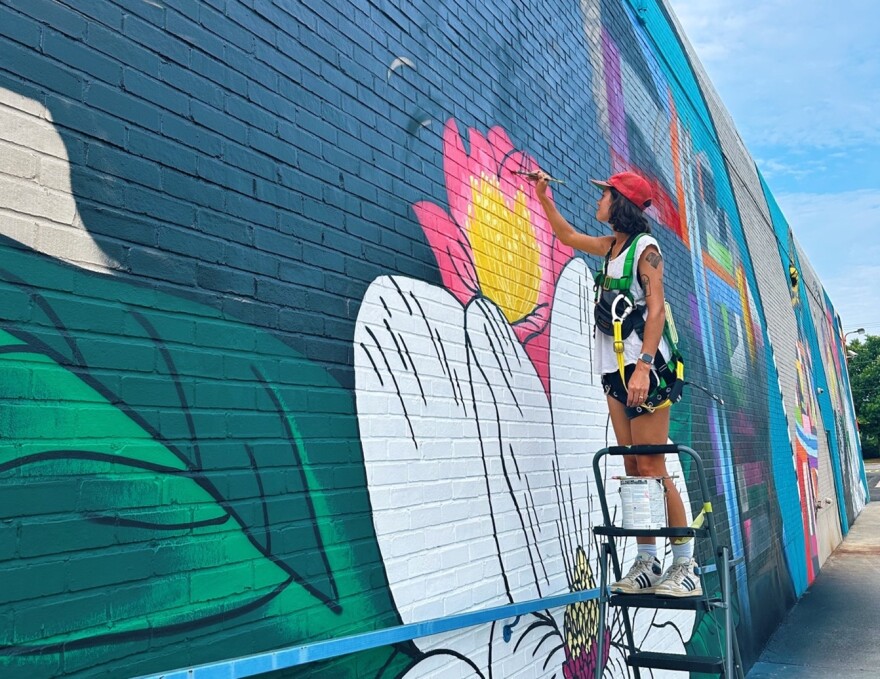A new mural sits in the heart of downtown Birmingham, honoring the legacy of four Alabama women and putting visitors directly into their story. The public art piece, titled “Steel Magnolias,” can be spotted on the corner of 19th Street North and 10th Avenue, just across from the Birmingham Jefferson Convention Complex (BJCC).

The mural is now part of the DCI building, home of Main Street Inc., a Birmingham-based digital printer. It replaces what once was a blank, beige wall with quilted patterns, flowers and the portraits of local historical legends. Meghan McCollum is the founder and owner of Blank Space Bham, which is an organization that installs and manages public art projects across the Magic City. McCollum said building owners wanted to capitalize on the ongoing revitalization taking place in the area, from City Walk to renovations at the Legacy Center, and that this mural was one way of doing so.
“They saw this blank canvas opportunity, a 260-foot-long wall, and wanted to give back to the community with the gift of public art,” she said. “They wanted to offer back in a way that was more than just the beige wall they had previously. They wanted to [promote] a theme of bridging the divide and providing hope for a bright future in the Magic City.”
DCI building owners created a volunteer-based mural committee made up of employees from Main Street Inc. The committee brainstormed mural ideas and sought proposals from local artists. McCollum’s proposal was selected. She began conceptualizing “Steel Magnolias” in January. McCollum, alongside local artists Dewon Moton and Mary Grace Tracy, picked up their paintbrushes over the summer and completed the wall within two and a half weeks.
“It gave me a lot of freedom to be able to say, ‘Who inspires me as an artist and as a person? Who do I envision embodying that idea of bridging the divide?’” she said. “I, ultimately, arrived on the four famous women in this piece and how, for me, each of those women bridged the divides across communities and embodied this idea of strength and grace, which comes to that idiom of Steel Magnolias.”

The mural features four historic women who both overcame adversity and planted their roots in the state of Alabama. They include Harper Lee, Coretta Scott King, Rosa Parks and Helen Keller. Harper Lee was a Pulitzer Prize-winning author known for her 1960 novel, “To Kill a Mockingbird,” which sold more than 40 million copies and received translations in over 40 languages. Coretta Scott King was a leader in the civil rights movement and the Women’s Movement. She was an activist, author and wife to Martin Luther King Jr. Rosa Parks was also a civil rights activist, notoriously known for her role in the Montgomery bus boycott, which was the first large-scale demonstration against segregation in the U.S. Helen Keller was the first deafblind person in the U.S. to earn a bachelor’s degree, and she later became a disability rights advocate and world lecturer.
While these women have their differences, McCollum said they all teach women and Alabamians what it takes to be a leader.
“In a lot of ways, there’s this distinction in what they did, but the thread that ran through all of these stories and their characters was this boldness and this grace under pressure,” she said. “They dealt with a lot of adversity in ways that [made them] rise to the occasion. They made the most of their voices and their opportunities. I wanted to create a large-scale piece of inspiration not only women for that come and see this piece but for everyone. These are larger-than-life representations of people, who boldly use their gifts to change the world. While it may not be obvious at first [viewing] how these women are connected other than their Alabama roots, it would be the fact that they're Steel Magnolias. They're strong under pressure.”
However, McCollum said there is a fifth woman who is just as important as the rest, and that woman is the viewer.

“What’s beautiful is that there are these four iconic women, but at the center of this piece is a nameless woman, the everyday woman, if you will,” she said. “She’s really to serve as a reminder that you can see yourself in this person. You can change the world, thanks to the seeds that have been planted by the Steel Magnolias of the mural. While these women have characteristics that made them extraordinary, we also, as individuals, have the potential to harness those same gifts to make an impact in our community.”
In addition to who she is, McCollum said the fifth woman’s placement and action within the mural also signifies meaning.
“The gentle gesture of her hands with a butterfly embodies change and how [that change] is going to make an impact and share beauty and happiness. The kind of blue, turquoise arches are supposed to be abstracted water reeds. This is talking about how what you do and put out into the world can ripple out and change communities for the better,” she said.
This is not the only part of the mural with special or hidden meaning. The abstract shapes, colors and quilted patterns found throughout the mural represent the Gee’s Bend quilters, who are a group of African American women whose art and history date back to their ancestors’ enslavement during the 19th century.

“We’re kind of mimicking their style of using bold colors and shapes and things like that. While we couldn’t put all of their faces in that mural, that’s, hopefully, our humble nod and acknowledgement to their rich contributions to our cultural heritage and the storytelling that they’re able to accomplish through quilting,” McCollum said.
The mural also features the state flower, Camellias, as well as magnolias.
“The Magnolia and Camellia represent the mural’s namesake but also the beauty of how these women led,” McCollum said. “They allow this almost symbolism that speaks to [how] these women blossomed into their own legacy and how we too can blossom in that same way.”
While these symbols offer insight into Alabama’s influential women, McCollum said they also harbor personal meaning.
“I like to incorporate these flowers, flora and fauna as much as I can as a tie to my own childhood and my own identity as this Southern woman and the Steel Magnolias that have impacted my life and strength,” she said. “While these women could have quite literally spoken for themselves with just their portraits, having these flowers is a nod also to my childhood and reminds me of the women who were strong in my life that got me to where I am.”
Though the mural is fully painted, DCI building owners partnered with Detroit-based company Electrify Collective to digitize and animate the mural for mobile devices. Visitors can pull out their smartphones and scan the on-site QR code. From there, viewers will see the mural in a brand new way, as flowers blossom and butterflies soar before their very eyes. The feature will also recite quotes from the four historic women and link to organizations these women supported or that share their work with the world. Augmented reality will be available for all visitors next month.

Above all else, McCollum said she hopes this mural helps counteract common, negative narratives made about the state and its residents.
“I think a lot of times, we’re presented with very specific narratives about [Alabama] and the people that live there,” she said. “I want this to serve as a reminder of the goodness that comes from Alabama. In this city, Birmingham [has] such a dark and storied history with the civil rights movement and racism, but it [shows] how a lot of strength and beauty came out of the resolve of women and men fighting for change, to change the story, change their community and change the world.”
McCollum said she also hopes this mural will pave the way for future public art initiatives in the Magic City.
“[It] shows the community that Birmingham is capable and worthy of world class art that is beautiful and is aspirational,” she said. “It’s not just something that’s pretty to look at, but it serves as a reminder of what we have been through and what we can look forward to in terms of strength of character and how we can grow and change our communities. There’s good things in Birmingham, and there's good things ahead for us as a city. People are excited to be here and to invest here. They want to come here and share their stories and see themselves reflected on the walls.”
“Steel Magnolias” will soon have its own social media page on Instagram for non-local viewers to view. Until then, more information about the mural and Blank Space Bham can be found through the organization’s website. Blank Space Bham’s Instagram page also chronicles the painting process of the mural. For readers looking to view “Steel Magnolias” in person, McCollum recommends dropping by downtown during the weekends, early mornings or evenings. These are the best times to avoid city congestion and crowded street parking.


